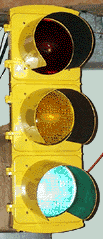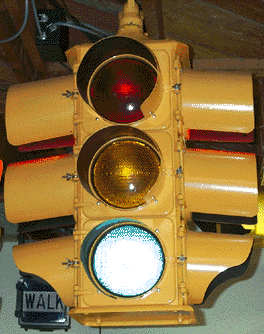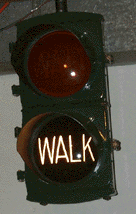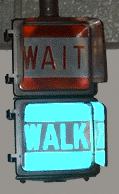Eagle Signal Signals
|
|

|
 |
These signals are held together with 2 rods that run from top to bottom and have end plates. This model is known as the Eaglelux. The end plates on the top and bottom have a rounded "decoration" similar to the Crouse Hinds Art Deco end plates, so I like to call these signals Eagle Art Decos. Some early signals of this model did not have any logo cast in the body on the back as newer models did. Instead, there is a small ID tag riveted to the top or bottom plate on the signal. The signals have glass lenses with the STOP GO flag logo embossed in the center (with the exception of the WAIT WALK lenses) and they also have glass reflectors. | |
 |
Here is a very rare signal. It is an ornamental Eaglelux made by Eagle. This signal came before the Eaglelux's shown above. It has a solid cast body instead of a sectional body. The body of the signal is one piece cast with provisions for 3 doors/lenses/reflectors. The visors are cast into the door as one piece also, so the main aluminum parts of this signal are made up of just 7 pieces. The body, the 3 doors and the 3 reflector frames. The mounting hardware that is used here is representative of what was used on these signals when they were new in the early 1930's. The actual finials I used are reproductions. The ball crosses that the finials are screwed into have tapered threads, not straight threads. Actual signal hardware has straight threads. The sequence shown in the animation is what some signals did before national standards were developed. When going from green to red, the yellow light would come on with the green for 3-5 seconds, then both would go off and the red would come on. In the animation, there is a slight dark period between the green/yellow and red change and between the red and green change. This was done to mimic old electromechanical controllers that sometimes were a bit sloppy when changing indications. The actual controller that I have running this light, the CH PCN 100, does have this brief dark period between indications which adds to the classic look of this signal. To see more about this signal, click here. | |||
| Most older 4 way beacons including all of the others in this collection have cutaway visors. When this beacon was acquired, it didn't have any visors. So I decided to get a set of each type of visor for it to change its look. It certainly looks different with tunnel visors! The red side of the beacon can be seen by putting your mouse on the top picture. | ||||
 |
The left side head in the 3 way cluster is an older type with two rods on the inside that hold the sections together with end plates on the top and bottom. The pedestrian signal on the right is also held together with rods and end plates. These are newer than the Eaglelux models. They lack the rounded "decoration" that Eaglelux signals have. The pedestrian signal has a rare lunar blue WALK lens. Put your mouse over the picture to compare it to a standard WALK lens. Click here to see more pics of these and other Eagle heads. |
|
 |
Here are two 12 inch aluminum signals. They are both flat back signals. The animation on the right shows the operation of LEFT turn signals in Michigan. Some LEFT signals in Michigan begin a flashing RED indication when the thru traffic gets a green so that the LEFT traffic can proceed when the on coming thru traffic is clear. Once the thru traffic is stopped by a red signal, the LEFT traffic gets a green arrow, yellow arrow and then back to solid red. To see an animation of this that may provide a better understanding, click here. |
|
 |
Here is a 12 8 8 flat back signal. This signal originally served in Parma, Ohio. The yellow and green lenses have the same bead pattern as the STOP/GO flagged lenses that were seen in Eagles of this variety, but the logos on these lenses are the newer Eagle in a square logo. The red lens has no logo. |
 |
Four way fixed face signals. These are probably some of the last made since they both have metal reflectors and the frames are cast like those found in newer Eagle heads. Both have all glass lenses with the STOP GO logo in the middle. |
 |








